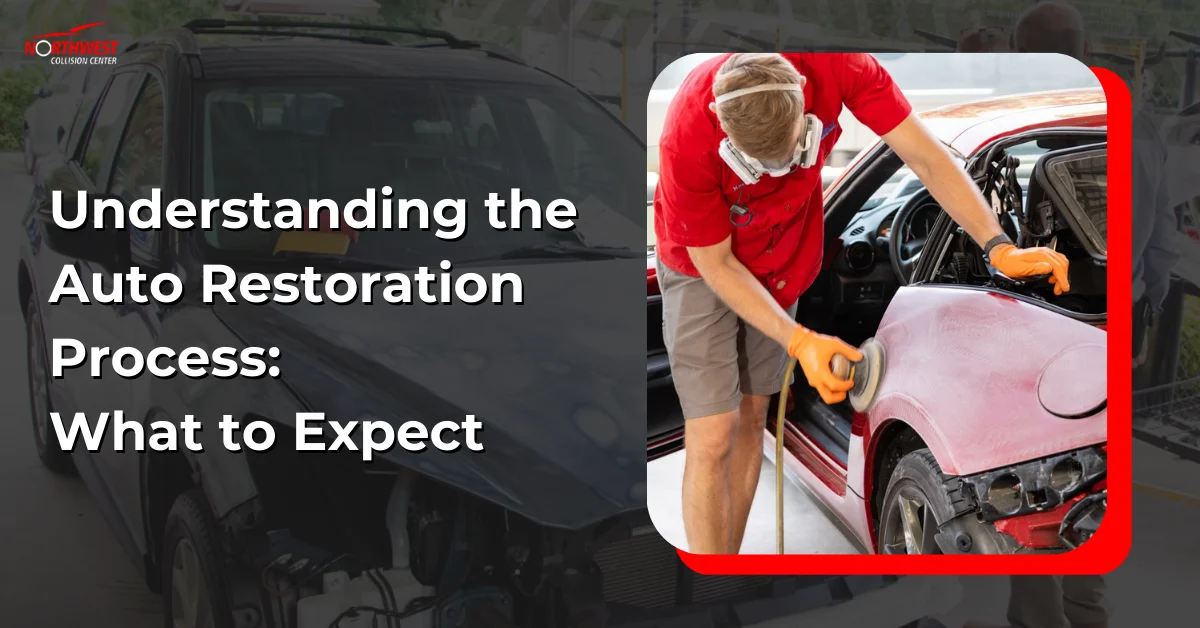Auto restoration is a thrilling journey that demands careful planning and precise execution. First, you’ll assess your vehicle’s condition and create a budget with a contingency fund for unexpected costs. As you prepare the vehicle, check for rust, mechanical functionality, and interior quality. Bodywork comes next, where you’ll focus on surface preparation and applying high-quality paint. Don’t overlook engine and system assessments; inspect each component for performance. Finally, you’ll add the finishing touches to enhance both esthetics and value. Ready for the detailed steps that can take your classic car resurrection to the next level?

Key Takeaways
- Begin with a thorough assessment of the vehicle’s condition to identify necessary repairs and prioritize tasks effectively.
- Establish a realistic budget, including a contingency fund, to cover unexpected expenses during the restoration process.
- Utilize expert assistance for detailed inspections, sourcing quality parts, and ensuring compliance with safety regulations.
- Focus on meticulous bodywork and finishing touches to enhance the vehicle’s aesthetic appeal and overall value.
- Document all modifications and maintenance to preserve the vehicle’s history and enhance its market value post-restoration.
Plan Ahead
When you’re planning your auto restoration project, it’s essential to define your budget upfront to avoid unexpected expenses down the road.
Next, finding the right vehicle that meets your esthetic and performance goals can set the foundation for a successful restoration.
Finally, setting up your work area and creating a realistic timeline will streamline the entire process, ensuring you stay focused and motivated.
Define Your Budget
Defining your budget for auto restoration is essential, as it often directly influences the quality and extent of the repairs your vehicle will receive. Start by evaluating the current condition of your car. Identify the areas needing repair—whether it’s bodywork, engine overhauls, or esthetic enhancements. Each element carries its own costs, and understanding these upfront helps prevent unexpected expenses down the line.
Next, research various auto restoration services. Compare their offerings, expertise, and pricing. This comparison won’t only help you gauge what’s reasonable but also allow you to prioritize essential repairs over luxury upgrades.
Factor in additional costs like parts, labor, and any potential hidden fees that might arise during the restoration process. It’s also wise to set aside a contingency fund—about 10-20% of your total budget. This guarantees you’re prepared for surprises, like discovering more extensive damage once the restoration begins.
Ultimately, a well-defined budget not only facilitates a smoother restoration experience but also maximizes the value you get from your investment. Remember, this isn’t just about reviving a classic car; it’s about reviving a piece of history.
Find the Right Vehicle
How do you choose the right vehicle for restoration? Selecting the perfect candidate for auto restoration is essential to guarantee a rewarding project. Start by considering these three key factors:
- Condition: Look for a vehicle with minimal rust and structural damage. The less work needed, the better your restoration experience will be.
- Parts Availability: Make certain replacement parts are readily accessible. Classic models with a strong aftermarket support will save you time and money.
- Personal Affinity: Choose a vehicle that resonates with you personally. Passion fuels the restoration process, making long hours in the garage enjoyable rather than a chore.
Set Up Your Work Area
Setting up your work area is essential for a successful auto restoration project, and taking the time to plan can make all the difference. Start by choosing a spacious, well-lit location, free from distractions. Confirm you have adequate ventilation if you’re working with chemicals or paints—safety should always come first.
Next, organize your tools and equipment. Invest in a sturdy toolbox to keep your hand tools accessible and labeled. For larger equipment, designate specific areas to avoid clutter. A clean workspace enhances efficiency and minimizes the risk of losing essential tools.
Consider incorporating a parts inventory system. As you disassemble the vehicle, label and store components systematically. This practice will save you time during reassembly and confirm you don’t misplace critical parts.
Lastly, confirm you have all necessary materials ready, from paint to replacement parts. If you’re unsure about any aspect, consulting with an auto restoration service can provide valuable insights.
With a well-prepared work area, you’re setting the stage for a successful restoration journey, allowing your passion for classic cars to shine.
Create a Timeline
Creating a detailed timeline for your auto restoration project is essential to guarantee each phase unfolds smoothly and efficiently. A well-structured timeline helps you manage your time, budget, and resources effectively, ensuring that you stay on track.
Here’s how to create one:
- Define Major Phases: Break down the restoration process into major phases such as disassembly, repair, and reassembly. This will help you visualize the entire project.
- Set Milestones: Establish specific milestones for each phase. For example, aim to have all auto restoration parts sourced by a certain date. This encourages accountability and keeps you motivated.
- Allocate Time: Assign realistic time frames for each task, considering potential delays. Whether it’s finding rare auto restoration parts or waiting for paint to dry, a buffer can save you headaches later.
With a clear timeline, you’ll navigate the complexities of your restoration project with confidence.
Preparing the Vehicle
Preparing your vehicle for restoration involves a meticulous assessment of its current condition and identifying any necessary repairs. Start by examining the body for rust, dents, and any signs of previous damage. Document these issues, as they’ll guide your restoration process.
Pay close attention to the vehicle’s paintwork—this is where auto paint restoration becomes essential. You’ll want to assess whether the existing paint is salvageable or if a complete repaint is needed.
Next, check the mechanical components, including the engine, brakes, and suspension. Confirm all systems are functional, as this will impact your restoration timeline and budget.
Don’t overlook the interior; evaluate the upholstery, dashboard, and electronics. Any deterioration here can detract from the vehicle’s overall appeal.
Once you’ve completed your assessment, create a detailed list of repairs and restorations needed. This will serve as your roadmap, helping you prioritize tasks and allocate resources effectively.
Bodywork
When it comes to bodywork, attention to detail is paramount for achieving a flawless finish.
You’ll need to focus on several critical aspects of auto body repair to guarantee your classic car looks its best. Here’s what you should prioritize:
- Surface Preparation: Start by sanding down any imperfections, rust, or old paint. A smooth surface is essential for proper adhesion of new paint and finishes.
- Panel Alignment: Confirm all body panels fit correctly. Misaligned panels can lead to both esthetic issues and functional problems, especially when it comes to doors and hoods.
- Paint Application: Use high-quality paint and proper techniques for application. Techniques like spray painting require precision to avoid runs or uneven coverage.
Each step in the bodywork process is interlinked, and skipping any of them can compromise the integrity of your restoration.
Whether you’re dealing with dents or scratches, meticulous attention to every detail not only enhances the vehicle’s appearance but also retains its value.
Your passion for preserving classic cars will shine through in the final product, making all your efforts worth it.
Assess the Engine & Other Systems
Regularly evaluating the engine and other systems is fundamental for guaranteeing your classic car runs smoothly and efficiently.
Begin with a thorough inspection of the engine, checking for leaks, corrosion, and wear. Pay attention to the belts and hoses; they can degrade over time and should be replaced as needed. Test the ignition and fuel systems to confirm they’re functioning at their best, as these components are essential for performance.
Next, turn your focus to the transmission and braking systems. These elements are imperative for safety and control, so verify the fluid levels and inspect for any signs of damage.
Don’t overlook the electrical system either; a reliable battery and intact wiring are crucial.
If you’re unsure about any of these assessments, consider consulting auto restoration shops specializing in classic cars. Their expertise can save you time and potential headaches.
They’ll not only pinpoint issues but also provide recommendations for the necessary repairs or upgrades.
Finish the Build
Completing the build of your classic car is where your vision truly comes to life, transforming parts and pieces into a masterpiece on wheels.
As you finalize your project, focus on the details that bring your classic auto restoration together. Here’s what you need to verify your build shines:
- Finish the Paintwork: Verify a flawless finish by applying high-quality paint. This not only enhances esthetics but also protects the body from the elements.
- Install Interior Components: Revitalize the interior with new upholstery, dashboard, and accessories. A well-appointed cabin adds to the overall experience and value.
- Quality Control: Before hitting the road, perform a thorough inspection. Check systems like brakes, lights, and electrical components to guarantee safety and performance.
Frequently Asked Questions
What Are the Costs Associated With Classic Car Restoration?
When you consider classic car restoration costs, factor in parts, labor, and specialized services. You’ll likely invest in both esthetic upgrades and essential repairs, ensuring your vehicle not only looks great but performs safely.
How Long Does a Typical Restoration Project Take?
A typical restoration project takes anywhere from a few weeks to several months, depending on the car’s condition and complexity. You’ll need to plan accordingly, ensuring you allow enough time for thorough, quality repairs.
Can I Restore a Car Without Professional Help?
You can restore a car without professional help, but it’s challenging. You’ll need technical knowledge, tools, and patience to achieve quality results. Consider the risks; professional assistance often guarantees precision and value retention.
What Types of Classic Cars Are Easiest to Restore?
Think of classic cars as timeless treasures waiting for your touch. Models like the Ford Mustang and Chevrolet Camaro are often easier to restore due to their abundant parts and enthusiastic communities, ensuring you’re never alone in the journey.
How Do I Choose the Right Restoration Shop?
To choose the right restoration shop, assess their experience, check client reviews, and inquire about their specific services. Verify they prioritize esthetics and safety, and confirm their expertise with your car’s brand for ideal results.
Conclusion
Restoring a classic car is a comprehensive process that combines passion, precision, and the right auto restoration services. Whether it’s auto body repair, auto paint restoration, or auto interior restoration, each step demands skilled craftsmanship and attention to detail. Finding reputable auto restoration shops ensures access to quality auto restoration parts and experienced auto body technicians who can handle everything from auto body work to auto body paint. By entrusting your vehicle to professionals, you’re not just enhancing its appearance but preserving its history. A well-executed classic auto restoration is a celebration of both performance and heritage, turning your car into a timeless masterpiece.
Restoring a classic car isn’t just about esthetics; it’s a journey that intertwines craftsmanship with a profound respect for history. As you meticulously assess and revive every component, you uncover a deeper connection to the past. Each decision, from materials to techniques, shapes not only the car’s performance but also its story. Embrace this process with passion, and you’ll realize that every restored classic is a tribute to dedication, preserving not just a vehicle, but a piece of automotive heritage.










